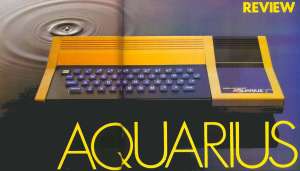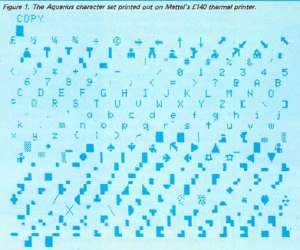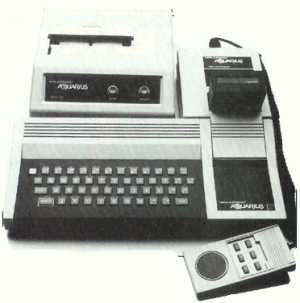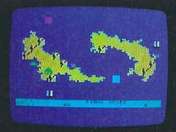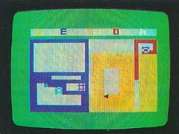|
Will Mattel's £90 colour Aquarius make a big splash? Don Wilson checks out the U.S. newcomer. PLAYING GAMES is a serious business for toy-maker Mattel. The U.S. giant already has plenty of experience in the multi-million pound video-games field with its Intellivision system. Now the £90 Aquarius is Mattel's way of saying that it is ready to take on the home computer market. Mattel originally planned just to upgrade the Intellivision games machine to a home computer. I saw the prototype in the U.S. some four years ago. Even though Intellivision owners will soon have the keyboards that will turn their machines into micros, Mattel also decided to build a complete home computer, the Aquarius, as a totally separate project. |
|
|
At £90 for the basic computer, the Z-80A based Aquarius is priced to compete with the ZX-81, Spectrum, Oric and Vic-20. It has a 40-column by 24-line display and graphics resolution is high at 320 by 192. The pre-defined graphics in the Aquarius character set — see figure 1 — can be Poked to the screen or printed using the CHR$ command. |
|
Text and graphicsMattel's Aquarius runs a standard form of the widely-used Microsoft Basic — the same that is resident in the Dragon 32, for example. Unlike the Dragon, however, text and graphics can easily be mixed. Dutifully following the steps a first-time user would take, I started with a look at the manual which like the Aquarius itself is produced in Hong Kong. I was pleasantly surprised by this well-written book — in fact it is one of the best I have seen. |
It does not suffer from the awkward English that mars many manuals printed in the Far East, nor does it assume a knowledge of computers. It uses a step-by-step approach to most topics and there are no lengthy explanations of the inner workings of the machine. My one complaint is that it has no alphabetical index. As well as the manual you are supplied with a ring-binder of quick-reference cards. They are designed to come to your rescue if you start to panic at the keyboard. |
The micro's 49 moving keys are small and rubberised — similar to the Spectrum's but require a far firmer touch than those on Sinclair's machine. There is no full-size space-bar. I found that it was very easy to mis-type — you think that you have pressed a key only to find several characters further on that a letter is missing. The Aquarius also lacks an auto-repeat facility. If you hold down a key on Mattel's machine the character will not carry on being repeated until you lift your finger again. |
Multi-function keysLike the Spectrum, the Aquarius has multi-function keys. A keyboard overlay shows you which keys give the facility to print such commands as Run, List, Goto, CLoad. I find multi-function keys particularly useful because they make for faster programming. On the Aquarius, as on any other machine that uses this feature, it took a little time to get used to the location of the particular keywords. |
Minor features that the Spectrum cannot boast are the Aquarius on/off switch and power-on light. It also has a reset button, so it is not even necessary to turn off the power while the machine is in use. I like the position of the reset button at the top left-hand side of the keyboard. As an added safety measure the button is protected by a wall to avoid accidental erasure of programs. Even if you do inadvertently trigger the reset, you can still rescue a program in the machine simply by pressing Ctrl C which returns a Break message. |
When you first switch on, text appears in black on a light-blue screen. At first I had problems getting all 16 colour variations. However when I moved to another television set I found that the Aquarius really does produce all the shades it promises, but with a tendency towards the blue/green end of the spectrum. The eight extra colours which the Aquarius offers and which the Spectrum does not are just light and dark shades of the basics, but their existence gives more variety to any program that uses graphics. |
|
The basic machine has only one sound channel. Although the manual claims you can use the Aquarius "to create an astonishing range of sound by specifying duration and tone with the Sound statement" it does not elaborate on how this may be done apart from the unhelpful advice "in general the higher the tone number the lower the tone". With the Mini Expander two extra sound channels become available, which puts the Aquarius on a par with the Vic-20. |
I carried on through the handbook, typing out a number of the simple programs provided. It was at this stage I met a problem. The Aquarius does not come supplied with a cassette lead. There is a normal five-pin DIN socket at the back of the machine. You are told to plug into the Mic/Ear socket of your tape recorder and ignore the remote since the machine does not recognise it. I am told that the Tandy lead supplied for the TRS-80 is compatible. A cable is supplied with the £50 Data Recorder which can be bought as an optional extra. |
At the top right of the console is a removable cover which conceals the expansion port. Most of the cartridges sold with the Aquarius can be plugged straight into the cartridge port without any additional memory. There is even a self-contained word processor — although, 1,731 bytes of memory will not allow you to write much more than the opening paragraph of your long-planned autobiography. |
|
Into this expansion port is plugged the Mini Expander Module. Priced at around £50, this add-on is essential if you wish to have extra memory or use the game paddles. Although most of the games can be played from the computer keyboard, most enthusiasts will want to use paddles, for greater flexibility. If, like me, you like to have your computer on a table with a television set behind it, plugging in the Mini Expander changes the shape of the Aquarius from a neat oblong into a bulky L shape. |
The program and memory cartridges slot into two ports at the top of the expander. Initially I found them difficult to fit — they require a firm push to ensure a perfect connection. Two modules are available for increasing the memory — 4K, which gives a total of 5,827 usable bytes, and 16K which means 18,115. Mattel claims the Aquarius will be capable of expansion to 52K, and so I must assume that other memory modules will become available. |
A 40-column thermal printer is an optional extra. Priced at £140 it compares unfavourably with the ZX Printer at £40. It uses an RS-232 interface and produces a good, clear hard copy of program listings. It can also reproduce graphics. Like any printer that uses 4in. wide paper it is little use for anything else, such as producing lengthy documents. The more adventurous user will find that he will soon have to upgrade to a larger printer. It is here that I must start to seriously question the market at which the Aquarius is aimed. |
|
At first sight, the Aquarius' £90 price tag is attractive and may lure the unwary into buying a machine that very soon becomes expensive. Thinking that it will make a good first machine at less than £100 buyers could soon find that to run their own programs they need the Mini Expander Module to overcome the limitations of the Aquarius. This puts the price of the machine at around £140 — expensive for a games machine, and still no extra memory. The 4K RAM pack bumps up the price another £20 and the 16K cartridge another £50. So in order to reach 18K of RAM the machine is already priced around £200 — and even then cannot offer a real keyboard. |
|
|
Mattel promises a large selection of games cartridges which will be priced at between £15 and £20. But the two applications programs that I saw — the word processor and Finplan, which bore a resemblance to Vu-Calc on the Spectrum — are to be retailed at around £50. Since Spectrum's Vu-Calc is available on cassette for £8.95 the Aquarius version is pricey. Although there are very few cartridges available now the catalogue promises a reasonably wide selection and Mattel says that it will have "a considerable number" ready for the seasonal market — which presumably means the Christmas period. |
Other software houses have already indicated that they will be producing cassette-based programs for the machine straight after launch. This will at least bring down the price of software. On the hardware side Mattel is selling a Data Recorder for £50. This is not essential for the Aquarius — any reasonable quality recorder will do so long as it has mic and ear connections. My only reason for one would be aesthetics — it matches the colour scheme. |
A Modem is also promised for later this year. But with the machine's limited RAM, many networking facilities will be beyond it without the extra expense of more memory. Mattel will also be producing a Master Expansion Module to operate a dual disc drive which is claimed will bring the CP/M operating system to the computer. Mattel expects to sell more than 100,000 Aquarius micros and has already signed retailing deals with major High Street stores such as Smiths and Boots. I cannot help feeling that the limitations of the machine and the level of its price may mean that this is not the dawning of the age of Aquarius.¨ |
|
CONCLUSIONS |
|
